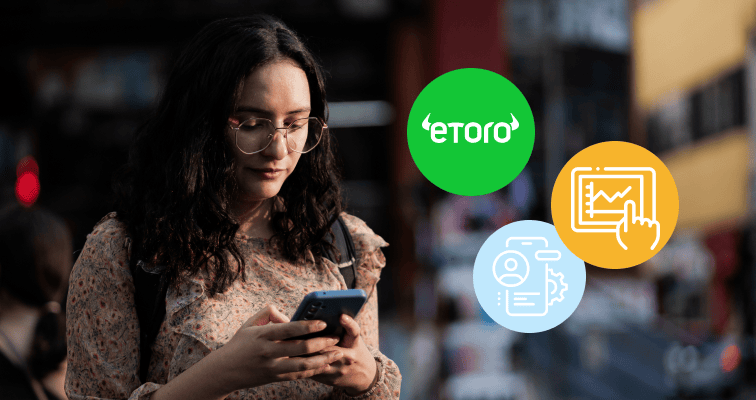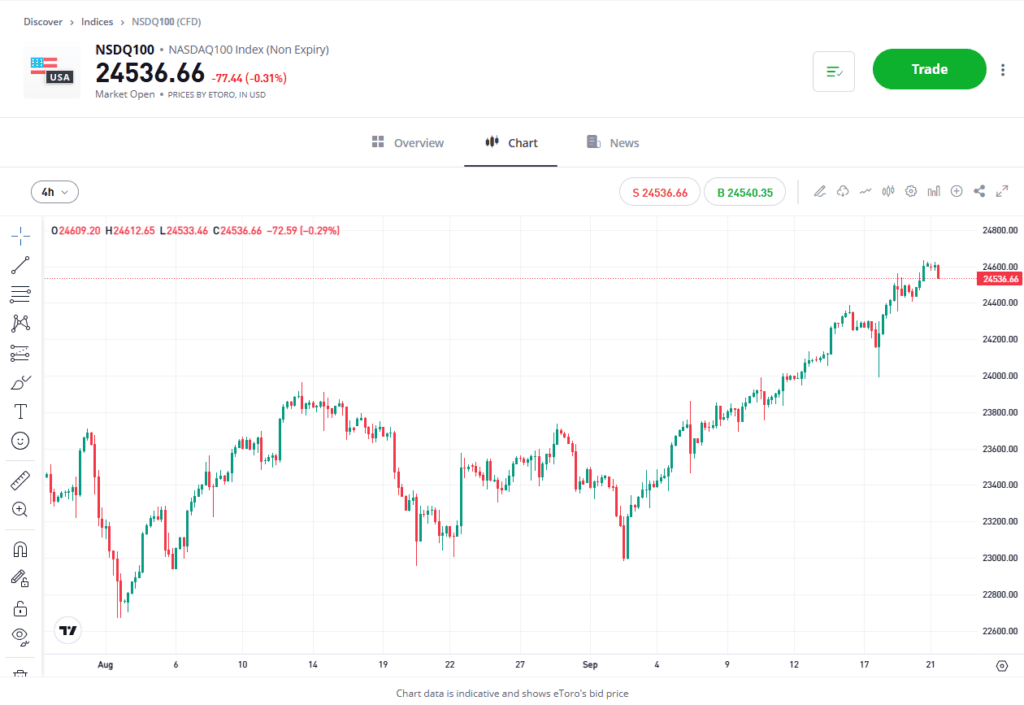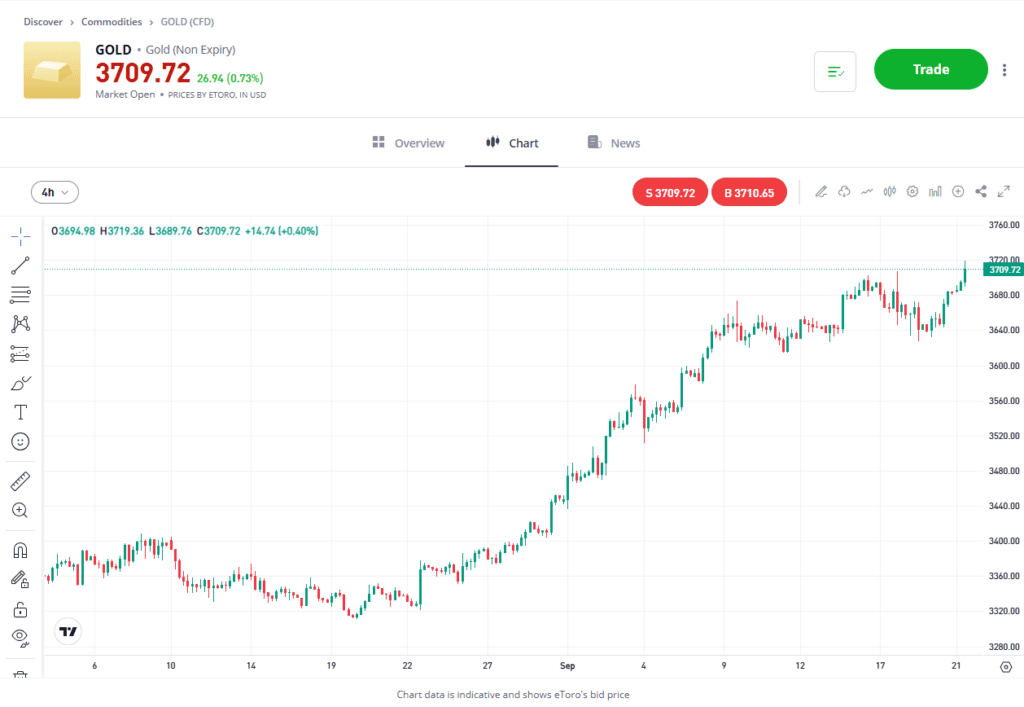If you’ve ever wondered whether futures trading might be for you, this analysis of how they work could help you to answer that question. We’ll explore what futures are, the types of futures which are available, and provide a step-by-step guide on how to trade them using an online broker.
Futures trading offers a way to invest in a wide range of different markets. There are, however, some important features to be aware of and a need to make sure you pick the type of futures contract that suits your style of trading.
This guide will outline what futures are and explain what steps are needed to put on your first futures trade.

What is Futures Trading?
Futures trading is buying and selling futures — which are a legally binding agreement to buy or sell an asset such as Bitcoin (QBTC) or the Nasdaq 100 Index (QNDX), on a specific date or during a specific month in the future, at a price agreed upon today.
Trading futures is very similar to trading many other instruments, but understanding the details of how any market works is always beneficial.
- Standardisation: The contract terms of a future traded on an exchange are standardised — the quality, quantity, delivery time and place are all fixed by the exchange, the only variable factor is price.
- Exchange cleared: Futures are exchange traded and highly regulated, reducing the counterparty risk and adding transparency for investors.
- Market access: Futures provide a direct and often cost-effective way to access a wide range of global markets accessible 24/5.
- Liquidity: Futures markets with high trading volumes can offer traders the benefits of improved liquidity which allows participants to enter and exit positions quickly and efficiently with minimal impact on the market price.
It’s important to know that while many futures trades are settled with cash, some require the trader to physically deliver the actual item. But all futures contracts on eToro are cash settled.
- Physical Delivery: In these contracts, there’s a direct connection to the underlying commodity. When the contract expires, a buyer (long position) is matched with a seller (short position), and the seller must deliver the actual goods to the buyer. Anyone holding a contract at expiration must either provide or receive the physical item.
- Cash Settlement: These contracts are settled purely with money. At expiration, a final price is set, and traders simply pay or receive cash to settle their position. No physical product ever changes hands, removing any obligation to handle the actual commodity.
Tip: Futures are derivative instruments — you are trading the right to buy or sell an underlying asset , rather than the asset itself.
Types of Futures that can be Traded
There are many different types of futures market and to ease understanding they are broken down into various sub-categories.
In reality, most financial futures are cash settled, and most commodity futures are physically settled, but the onus is on the trader to know the terms of the contract as that’s not always the case.
Traders looking to gain exposure to price moves in a market rather could trade physical but typically trade financial futures where settlement can be done using cash, or a position rolled over or closed prior to expiration via a financial transaction. Financial futures track markets such as stock indices, interest rates, currencies, crypto, and bonds. In fact, futures can technically be applied to any financial instrument. A more granular list of all of the groupings is as follows:
| Asset Class | Key Products |
|---|---|
| Equity Indices | E-mini S&P 500, E-mini Nasdaq-100, E-mini Dow Jones Industrial Average, and Russell 2000 index futures |
| Interest Rates | SOFR (Secured Overnight Financing Rate) futures, U.S. Treasury futures (2-Year, 5-Year, 10-Year Notes and 30-Year Bonds), and Fed Fund futures. |
| Currencies / Forex | EUR/USD, GBP/USD, and JPY/USD. |
| Cryptocurrencies | Bitcoin and Ether. |
| Energy | Crude Oil (WTI), Natural Gas (Henry Hub), Gasoline, and Heating Oil futures. |
| Agricultural | Corn, Soybeans, Wheat, Lean Hogs, and Live Cattle. |
| Metals | Gold, Silver,Copper and Platinum. |
| Misc | ESG, Real Estate, Weather. |
How does Futures Trading Work?
Futures allow participants to gain exposure in the market by going either long or short. Whichever approach you take, there are a variety of techniques you can use to manage and exit your trading positions.
- Offset – Do the opposite of your opening trade to close out your position (e.g., if you bought, you sell). This is the most common method.
- Roll – To keep your position open longer, sell your current contract and buy a new one with a later expiration date.
- Hold to Expiry – Let the contract expire. It will be settled with either a cash payment or the physical delivery of the asset.
An example of a trade which uses the offset approach could be one based on a trader who expects the price of oil to rise and opens a long position in the market by buying crude oil futures. As the price of a future is derived from the price of an underlying asset, should the oil price rise, the price of oil futures will rise as well.
Of course, should the price of oil fall, the P&L on your long futures position will fall as well.
Tip: Futures involve settlement at a future date, but your exposure to the market starts from the time you open a trade.
The simplest form of futures trading uses futures which involve cash settlement rather than physical settlement . The P&L on your trade will be determined by the difference between the price at which you opened your position and the price at which it is closed out. At eToro, all futures are cash-settled.

Contract specifications
Futures contracts are made up of certain specifications. These standardised terms apply to both physical and cash futures.
Whether you are using futures to hedge other positions, or apply speculative trading strategies, these are some of the terms you need to know:
- Ticker Symbol: A unique code which relates to a specific future. It identifies details such as the underlying asset which will be traded and the future’s expiration date.
- Contract Size: The amount of the underlying asset in one contract. For physical commodities, this is a set quantity (e.g., one corn contract is 5,000 bushels). For financial futures, it is often a multiplier (e.g., the E-mini S&P 500 contract is 50× the S&P 500 index level).
- Notional Value: The total economic value controlled by a single contract, calculated by multiplying the contract size by the current market price.
- Tick Size: The minimum price increment a contract can move. For the E-mini S&P 500 (ES) contract, the tick size is 0.25 index points, with each tick valued at $12.50.
- Price Limits: Exchange-mandated limits on how much a contract’s price can move up or down in a single day. These are most common for agricultural products and are designed to curb extreme volatility.
Futures trading evolved out of the commodity markets and the desire of farmers and industrialists to use physical futures to have certainty over when they would exchange goods for cash and at what price. While trading in physical futures is still supported, the introduction of cash futures has led to exponential growth in the futures markets and it is now possible to use cash futures to trade a wide range of underlying instruments.
At the same time the landscape of the futures exchanges has developed to accommodate further growth. The Chicago Mercantile Exchange which pioneered the introduction of cash futures in 1972, merged with CBOT in 2007 to form CME Group, the world’s largest financial market.


How to Trade Futures on eToro
Booking futures trades on the eToro platform follows the same route to that of any other instrument. Whether you are trading E-mini Nasdaq 100 futures or futures in the gold market, the layout and functionality of the dashboard will be the same.

Past performance is not an indication of future results

Past performance is not an indication of future results
The home page for each market will provide up-to-date research and input from other traders who are following the market. From there you can analyse price charts, market sentiment, and upcoming news announcements before deciding whether you want to click on the “Trade” button to buy or sell.

Past performance is not an indication of future results
On eToro, futures products work on a cash basis. You can trade into and out of futures positions at any time the exchange is open, and if you hold your future for longer it will be autoclosed out prior to the future’s settlement date.
Tip: Futures trading involves using leverage . You will have to ensure that your account has sufficient funds to avoid a margin call.
Futures available on eToro
The extensive range of futures markets available on eToro reflects the company’s position as a multi-asset broker which offers more than 5,000 instruments to its clients.
The range of markets available extends from traditional futures which track the S&P 500 Index to Spot-Quoted futures which offer exposure to cryptos such as Ethereum.
Final thoughts
Futures contracts are versatile instruments and the way they have been adapted to support different purposes can at first make trading them appear complicated.
Once you understand the features of the different kinds of futures, you will be in a better position to use that versatility to your advantage, and invest in futures to achieve your financial aims.
Visit the eToro Academy to learn more about popular investment strategies which use futures.
FAQs
- Am I at risk of physical delivery if I trade futures on eToro?
-
No. All of the futures and CFD futures traded on eToro involve cash settlement. There is no risk of buying a futures contract which involves delivering or receiving the underlying physical item on the settlement date.
- What are popular futures trading strategies?
-
Commonly used futures trading strategies include mean reversion, and spread trading, but the instruments are particularly popular with investors following trend-following strategies.
- What is a futures “rollover”?
-
The term “rollover” describes the practice of selling a futures contract that is close to expiring and at the same time, buying another futures contract with an expiry date which is further away in time. This allows traders to maintain continuous exposure to the market.
- What does the term “central clearing” mean?
-
When futures are traded using central clearing a central counterparty (CCP) also known as a clearing house, acts as an intermediary between buyers and sellers. The buyers agreement and commitment to put up funds on maturity date is with the CCP, and the sellers agreement to make delivery is also with the CCP. The CCP guarantees the trades, and manages the associated risks by asking the parties to provide margin. This process reduces counterparty risk and provides greater price transparency.
- What are “carry” costs?
-
Carry costs are the charges associated with holding a futures position overnight. The elements which make up carry costs include overnight interest charges on long positions (and potential interest credits on short positions), insurance, and any dividends received on stocks which are members of a stock index.
Factoring carry costs into your P&L calculations is important and can be aided by trading instruments such as Spot-Quoted futures which offer a more transparent pricing model and have live prices which more closely mirror the spot price of the underlying asset being traded.
This information is for educational purposes only and should not be taken as investment advice, personal recommendation, or an offer of, or solicitation to, buy or sell any financial instruments.
This material has been prepared without regard to any particular investment objectives or financial situation and has not been prepared in accordance with the legal and regulatory requirements to promote independent research. Not all of the financial instruments and services referred to are offered by eToro and any references to past performance of a financial instrument, index, or a packaged investment product are not, and should not be taken as, a reliable indicator of future results.
eToro makes no representation and assumes no liability as to the accuracy or completeness of the content of this guide. Make sure you understand the risks involved in trading before committing any capital. Never risk more than you are prepared to lose.


